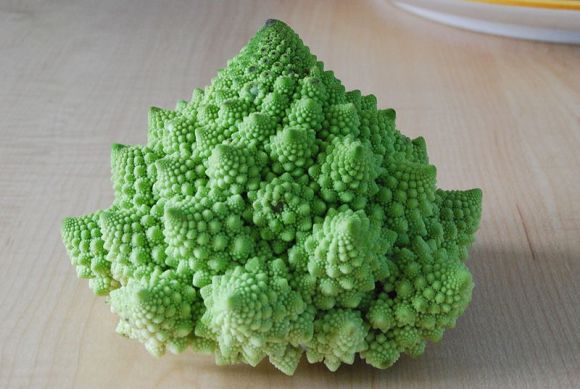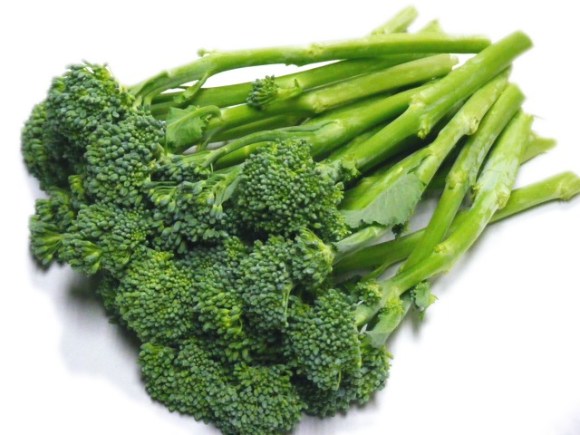
So, apparently numerous ’50s and ’60s B-Movies (and one glorious ’80s cartoon) and a popular, genre-defining video game weren’t enough to deter scientists from playing God with plant-life if the growing number of hybrid vegetables available on Japanese store shelves is any proof.
These days, most hybrid vegetables are created over a roughly 10-year period of crossbreeding certain seeds in what we presume is some kind of laboratory setting, although the practice has been alive for centuries – yielding some hybrids that the general public isn’t even aware are hybrids. The Romanesco, for example, is a cross between broccoli and cauliflower, and was created in the 16th century. Side note: It’s also probably mind blowing to look at while high.
But the things we’re seeing increasingly often in Japan these days are just plain weird.
Along with the Romanesco, another of the bizarre-looking hybrids recently on the rise in Japanese groceries is broccolini – a cross between broccoli and kale (aka “hipster feed”). Other new vegetables going on sale are purple carrots – which are not genetically altered and are actually more genetically “pure” than the orange ones we’re used to, ice plant, and a broccoli/”Kai-lan” Chinese broccoli hybrid that is called, as far as we can tell, “Stick Señor” in Japanese.
Other new vegetable aisle entries include artichoke, yacon, butternut squash, and orange cherries – generally all staples in other countries but never-before-seen in Japanese grocers.
Aside from the inevitable The Last of Us scenario, the sudden increase in vegetable selection available in Japanese grocery stores is significant given that the produce section as recently as a few years ago typically consisted almost solely of indigenously-grown fare, which limited the types of dishes one could cook – guaranteeing that restaurants and homes were unlikely to try non-traditional recipes and making homesick expats very, very sad.
Source: Naver Matome
Photos: Feature, Inset 1, Inset 2



 The broccoli wedding bouquet toss-Japan’s quirky substitute for the garter belt
The broccoli wedding bouquet toss-Japan’s quirky substitute for the garter belt Broccoli and chocolate? We try vegetables in chocolate fondue to test Japanese company’s claims
Broccoli and chocolate? We try vegetables in chocolate fondue to test Japanese company’s claims The new seasonal menu at family restaurant chain Jonathan’s is curiously simple…
The new seasonal menu at family restaurant chain Jonathan’s is curiously simple… Make your own Castle in the Sky, have an excuse to play with your food with this simple trick
Make your own Castle in the Sky, have an excuse to play with your food with this simple trick Tokyo pub offers “balding discount” for follicly-challenged diners
Tokyo pub offers “balding discount” for follicly-challenged diners Red light district sushi restaurant in Tokyo shows us just how wrong we were about it
Red light district sushi restaurant in Tokyo shows us just how wrong we were about it Japanese ramen restaurants under pressure from new yen banknotes
Japanese ramen restaurants under pressure from new yen banknotes Tokyo Tsukiji fish market site to be redeveloped with 50,000-seat stadium, hotel, shopping center
Tokyo Tsukiji fish market site to be redeveloped with 50,000-seat stadium, hotel, shopping center McDonald’s new Happy Meals offer up cute and practical Sanrio lifestyle goods
McDonald’s new Happy Meals offer up cute and practical Sanrio lifestyle goods Starbucks Japan adds a Motto Frappuccino to the menu for a limited time
Starbucks Japan adds a Motto Frappuccino to the menu for a limited time Beautiful Red and Blue Star luxury trains set to be Japan’s new Hokkaido travel stars
Beautiful Red and Blue Star luxury trains set to be Japan’s new Hokkaido travel stars New private rooms on Tokaido Shinkansen change the way we travel from Tokyo to Kyoto
New private rooms on Tokaido Shinkansen change the way we travel from Tokyo to Kyoto French Fries Bread in Tokyo’s Shibuya becomes a hit on social media
French Fries Bread in Tokyo’s Shibuya becomes a hit on social media Pokémon Sleep camping suite and guestrooms coming to Tokyo Hyatt along with giant Snorlax burgers
Pokémon Sleep camping suite and guestrooms coming to Tokyo Hyatt along with giant Snorlax burgers Japanese company starts project to restore Nakagin Capsules to capsule hotel
Japanese company starts project to restore Nakagin Capsules to capsule hotel All-you-can-drink Starbucks and amazing views part of Tokyo’s new 170 meter-high sky lounge
All-you-can-drink Starbucks and amazing views part of Tokyo’s new 170 meter-high sky lounge More foreign tourists than ever before in history visited Japan last month
More foreign tourists than ever before in history visited Japan last month Studio Ghibli releases new action figures featuring Nausicaä of the Valley of the Wind characters
Studio Ghibli releases new action figures featuring Nausicaä of the Valley of the Wind characters Starbucks reopens at Shibuya Scramble Crossing with new look and design concept
Starbucks reopens at Shibuya Scramble Crossing with new look and design concept Studio Ghibli glasses cases let anime characters keep an eye on your spectacles
Studio Ghibli glasses cases let anime characters keep an eye on your spectacles Beautiful Ghibli sealing wax kits let you create accessories and elegant letter decorations【Pics】
Beautiful Ghibli sealing wax kits let you create accessories and elegant letter decorations【Pics】 Studio Ghibli releases Kiki’s Delivery Service chocolate cake pouches in Japan
Studio Ghibli releases Kiki’s Delivery Service chocolate cake pouches in Japan New definition of “Japanese whiskey” goes into effect to prevent fakes from fooling overseas buyers
New definition of “Japanese whiskey” goes into effect to prevent fakes from fooling overseas buyers Our Japanese reporter visits Costco in the U.S., finds super American and very Japanese things
Our Japanese reporter visits Costco in the U.S., finds super American and very Japanese things Studio Ghibli unveils Mother’s Day gift set that captures the love in My Neighbour Totoro
Studio Ghibli unveils Mother’s Day gift set that captures the love in My Neighbour Totoro New Japanese KitKat flavour stars Sanrio characters, including Hello Kitty
New Japanese KitKat flavour stars Sanrio characters, including Hello Kitty New Pokémon cakes let you eat your way through Pikachu and all the Eevee evolutions
New Pokémon cakes let you eat your way through Pikachu and all the Eevee evolutions Disney princesses get official manga makeovers for Manga Princess Cafe opening in Tokyo
Disney princesses get official manga makeovers for Manga Princess Cafe opening in Tokyo Sales of Japan’s most convenient train ticket/shopping payment cards suspended indefinitely
Sales of Japan’s most convenient train ticket/shopping payment cards suspended indefinitely Sold-out Studio Ghibli desktop humidifiers are back so Totoro can help you through the dry season
Sold-out Studio Ghibli desktop humidifiers are back so Totoro can help you through the dry season Japanese government to make first change to romanization spelling rules since the 1950s
Japanese government to make first change to romanization spelling rules since the 1950s Ghibli founders Toshio Suzuki and Hayao Miyazaki contribute to Japanese whisky Totoro label design
Ghibli founders Toshio Suzuki and Hayao Miyazaki contribute to Japanese whisky Totoro label design Doraemon found buried at sea as scene from 1993 anime becomes real life【Photos】
Doraemon found buried at sea as scene from 1993 anime becomes real life【Photos】 Tokyo’s most famous Starbucks is closed
Tokyo’s most famous Starbucks is closed One Piece characters’ nationalities revealed, but fans have mixed opinions
One Piece characters’ nationalities revealed, but fans have mixed opinions We asked a Uniqlo employee what four things we should buy and their suggestions didn’t disappoint
We asked a Uniqlo employee what four things we should buy and their suggestions didn’t disappoint Princesses, fruits, and blacksmiths: Study reveals the 30 most unusual family names in Japan
Princesses, fruits, and blacksmiths: Study reveals the 30 most unusual family names in Japan What the…?!? Stuffed “Teddytaur” toy baffles and fascinates us at the same time
What the…?!? Stuffed “Teddytaur” toy baffles and fascinates us at the same time 【Breaking】This hamster kind of sucks at eating broccoli
【Breaking】This hamster kind of sucks at eating broccoli Japan’s most popular curry chain now has vegan soup curry, and it’s delicious【Taste test】
Japan’s most popular curry chain now has vegan soup curry, and it’s delicious【Taste test】 25 different Japanese convenience store sandwiches – What’s inside them?【Photos】
25 different Japanese convenience store sandwiches – What’s inside them?【Photos】 Japan’s hydrogen fuel cell stations begin to open, but are they worth the switch?
Japan’s hydrogen fuel cell stations begin to open, but are they worth the switch? Study shows broccoli sprouts may regrow hair, and not just on Chia Heads
Study shows broccoli sprouts may regrow hair, and not just on Chia Heads Japanese train stopped in its tracks after elderly resident leaves vegetables in its path
Japanese train stopped in its tracks after elderly resident leaves vegetables in its path Breathe easy – Toyota redesigning Prius plug-in hybrid to double car’s all-electric range
Breathe easy – Toyota redesigning Prius plug-in hybrid to double car’s all-electric range We tried this scrumptious all-you-can-eat Kyoto veggie breakfast buffet for only 500 yen
We tried this scrumptious all-you-can-eat Kyoto veggie breakfast buffet for only 500 yen My Neighbor Totoro fruit and vegetable shop series meets your daily nutritional needs for cute
My Neighbor Totoro fruit and vegetable shop series meets your daily nutritional needs for cute How to make one of the most complicated but awesome themed sushi rolls【Video】
How to make one of the most complicated but awesome themed sushi rolls【Video】 Tokyo’s Curry Udon Croquette Burger is four of Japan’s favorite foods in one【Taste test】
Tokyo’s Curry Udon Croquette Burger is four of Japan’s favorite foods in one【Taste test】 Pokémon GO players in Japan discover strange new hybrid species of monsters in the game
Pokémon GO players in Japan discover strange new hybrid species of monsters in the game Starbucks Japan’s new melon Frappuccino is part of a Japanese pun-themed dessert menu
Starbucks Japan’s new melon Frappuccino is part of a Japanese pun-themed dessert menu Kirby’s angry American version re-imported to Japan for the first time
Kirby’s angry American version re-imported to Japan for the first time
Leave a Reply